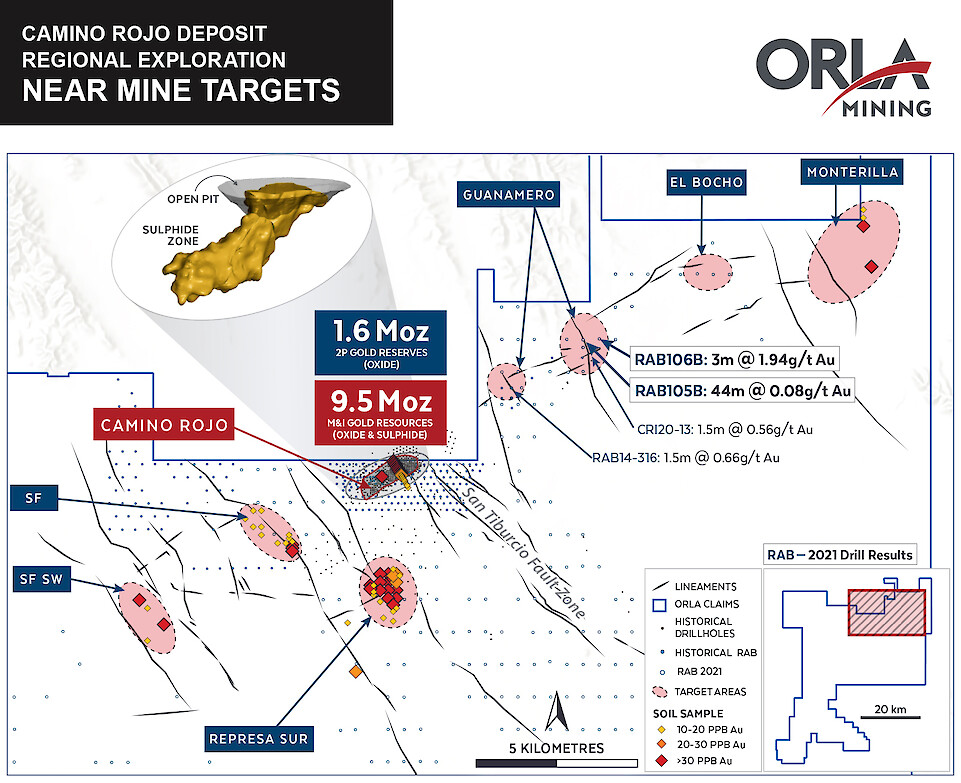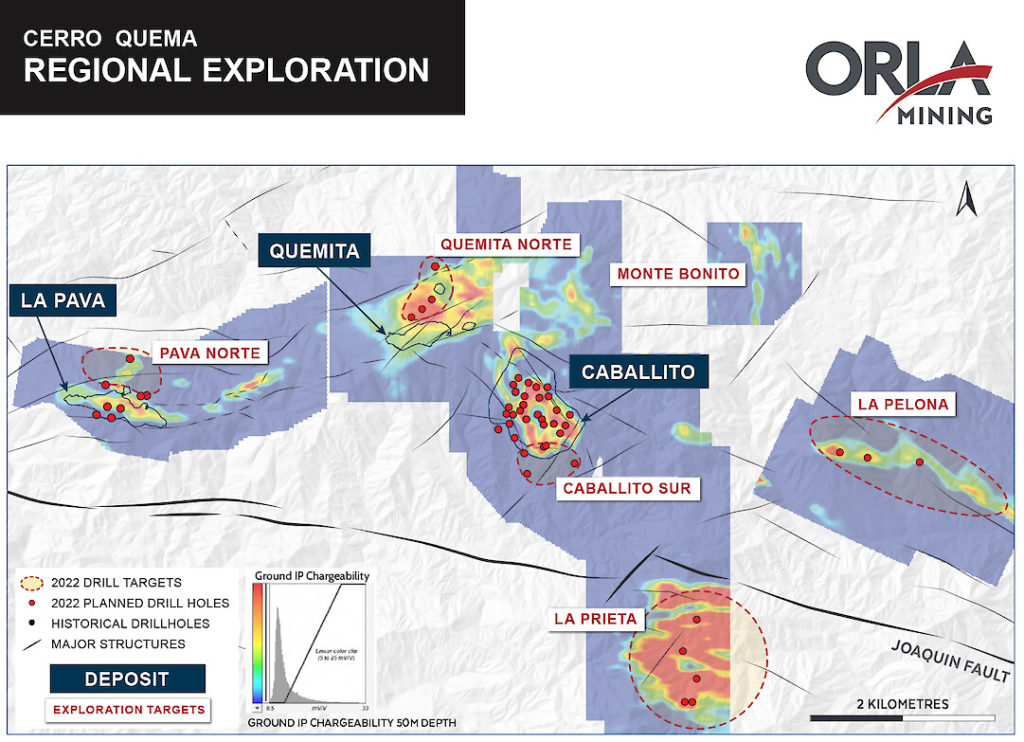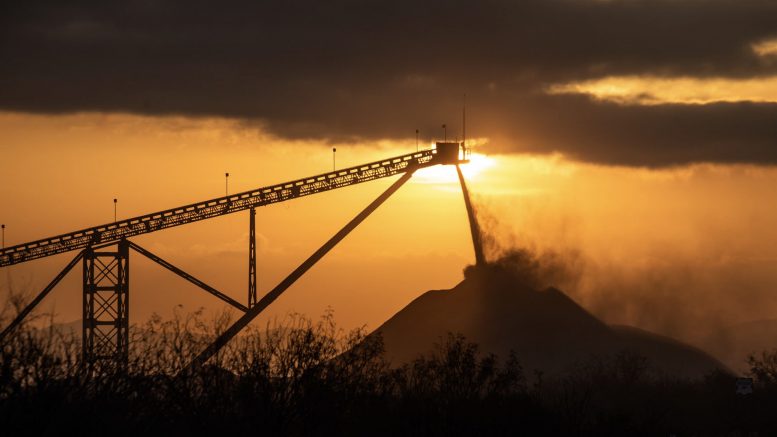Following the first gold pour in December at Orla Mining’s (TSX: OLA; NYSE: ORLA) Camino Rojo oxide gold mine in Mexico, the company is embarking on a 2022 exploration strategy that seeks to drive more value through the drill bit, COO Andrew Cormier tells The Northern Miner.
The Vancouver-based developer is currently ramping up production and anticipates declaring commercial production at its first new-build mine before the end of March.
In February, the company provided its initial production guidance, aiming for 90,000 to 100,000 oz gold over the next three quarters at all-in sustaining costs of US$600 to US$700 per oz sold. The project is expected to average about 120,000 oz gold annually over the first five years.
Cormier said the ramp-up had been progressing smoothly, allowing management to gradually return the focus to resource definition and expansion at near-mine and regional targets as the company aspires to achieve a 200,000-plus annual production profile. This includes an exploration work program at its Cerro Quema oxide gold-silver project in Panama, which includes an emerging copper-gold sulphide scenario.
“With Camino Rojo ramping up production and beginning to generate cash flow, Orla will gradually increase exploration expenditures. This disciplined allocation of capital to Mexico and Panama reinforces our ambitions of driving company value through discovery,” said Cormier in an interview.
Orla spent much of 2021 on drilling and advancing studies at the 100%-owned Camino Rojo sulphide deposit, representing a conceptual second phase of development as the company seeks to strategically scale output.
“We are currently focused on defining and prioritizing drill targets across the portfolio,” said SVP for exploration Sylvain Guerard. “In addition to increasing reserves at the Camino Rojo mine, efforts will be dedicated to upgrading and growing resources and drilling priority targets to make discoveries near existing deposits in Mexico and Panama.”
According to Cormier, Orla’s exploration spending for 2022 is expected to total US$15 million, with US$10 million earmarked for activities in Mexico and US$5 million for activities in Panama.
Drilling at Camino Rojo and Cerro Quema is set to begin in the second quarter and will continue through year-end.
Guerard said the exploration strategy at the Camino Rojo oxide mine entails near-mine and regional exploration focused on increasing oxide reserves, supporting the advancement of the sulphide deposit development scenario options, and testing priority targets defined in 2021 to make new satellite discoveries.

Orla wants to define additional oxide reserves at the Camino Rojo mine following confirmatory core drilling on the Fresnillo’s (LSE: FRES) property, immediately north and next to the Camino Rojo oxide open pit operation.
“While historical drilling indicates that mineralization continues across the property boundary onto the Fresnillo layback area, no ounces from this area are currently included in the Camino Rojo mineral reserve estimate,” Guerard said. “The planned 2,500-metre diamond drill program is designed to confirm and delineate mineralization in the oxide pit layback and allow for a potential update of mineral resource and reserve estimations,” said Guerard.
He said the successful 2021 core drill program would be followed by an 8,250-metre second phase campaign to further test the Camino Rojo sulphides.
The 2021 program comprised 6,079 metres across 14 holes on 100- to 250-metre drill spacing at a southerly orientation. Guerard said the program confirmed broad zones of higher-grade gold mineralization within the sulphide deposit while also providing material for a new metallurgical study, which is in progress.
“The 2022 program will infill drill the deposit and reduce the spacing to 50- to 125-metre fences. This tighter drill spacing on the more optimal south orientation, combined with the extensive south to north historical drilling, is anticipated to reinforce the geological model and confirm continuity of wide zones of higher-grade gold mineralization,” said Guerard.
The drilling is expected to support an updated resource estimate for the Camino Rojo sulphides, development planning advancement, and a preliminary economic assessment targeted for year-end.
Before 2021, exploration had focused on defining and expanding the Camino Rojo oxide deposit, with little work outside the area of the currently defined deposit and infrastructure.
In 2021, regional exploration focused on defining new exploration targets using a detailed airborne magnetic drone survey, an induced polarization (IP) survey, and multi-element soil geochemistry.
Orla also undertook a 9,146-metre, 284-hole regional rotary air blast (RAB) cover-bedrock interface program, with drill fences at 1,000 metres and drill holes at 500 metres along the fence. The aim was to sample bedrock below the shallow cover directly.
Guerard said the program intercepted “encouraging results of anomalous gold,” including 3 metres grading 1.94 grams per tonne gold and 44 metres at 0.08 gram gold, 7 km northeast of Camino Rojo.
As a result of this work, Orla identified several exploration targets along the Camino Rojo trend and south of the oxide mine.
Guerard explained these new exploration targets were hosted in rocks of the Caracol or Indidura formations, supported by geophysical and/or geochemical anomalies, and were located at the intersection of northwest-southeast structures associated with the San Tiburcio Fault Zone and northeast-southwest trending structures on or paralleling the Camino Rojo trend.
Drilling this year will occur on priority targets, with the company continuing work to generate new targets and a 10,000-metre RC drill program testing targets along the Camino Rojo trend and south of the Camino Rojo oxide mine..
“New deposit discovery remains the objective. This could include oxide deposits that support an extension of the mine life at the existing operation or additional sulphide deposits that strengthen and expand the already impressive sulphide endowment,” said Guerard.
Camino Rojo currently hosts proven and probable reserves of 67.4 million tonnes grading 0.73 gram per tonne gold for 1.6 million ounces of yellow metal. The measured and indicated resource base stands at 353.4 million tonnes grading 0.83 gram gold for 9.5 million oz., of which 255.45 million tonnes grading 0.88 gram gold for 7.3 million oz. are classified as sulphide mineralization.
Panama progress
Orla is also planning more infill and expansion drilling of known deposits, drill testing exploration targets defined by recent geochemical soil sampling, geophysical IP surveys, bedrock mapping and prospecting, and historical drilling at the Cerro Quema project in Panama.
The project entails a near-term gold production scenario and various exploration targets. Cerro Quema is also a proposed open-pit mine and gold heap leach operation.
According to Guerard, the program will comprise about 11,700 metres of drilling.
Like Camino Rojo, Cerro Quema also entails an oxide gold opportunity, but Cerro Quema has higher-grade sulphide copper-gold mineralization, presenting a potential future expansion scenario. The company also released an initial resource estimate on the Caballito outcropping high-sulphidation copper-gold deposit about 1 km south of the Cerro Quema oxide deposit.
Much of this year’s exploration in Panama will be devoted to further testing the Caballito deposit. Orla plans to undertake more infill and expansion drilling here, and more limited drilling at the La Pava and Quemita deposits.
“The aim is to convert more of the inferred resource to the indicated category, provide material for metallurgical testing, and test the continuity of mineralization and potential extensions of these deposits,” said Guerard.
The first resource estimates of copper-gold sulphide mineralization at La Pava and Quemita are planned for later this year.

As it stands, Orla’s 100%-owned Cerro Quema project hosts probable reserves of 21.7 million tonnes grading 0.8 gram per tonne gold and 2.18 gram silver for 562,000 oz. gold and 1.5 million oz. silver held in the La Pava and Quema deposits.
To date, the company has delineated an indicated resource for the Caballito sulphide deposit of 32 million tonnes grading 0.96 copper-equivalent for 676 million lb. of metal. An additional 22.6 million tonnes grading 0.85 g/t copper-equivalent hold 425 million lb. of copper-equivalent.
Orla also plans to hit regional targets at Cerro Quema this year.
Guerard said exploration target drill testing is planned to the north of the Quemita deposit to follow up on hole CQDH-17-112, which had previously intersected 76.5 metres at 0.87% copper and 0.15 gram gold from 68 metres depth.
“Drilling is also planned at the La Pelona target, which has a similar geophysical signature and geological context to La Pava and Quemita and has limited historical drilling,” said Guerard.
South of the regional Joaquin Fault, La Prieta, will also be drill tested. La Prieta is defined by a 1.4 km diameter IP chargeability anomaly with coincident gold, copper and molybdenum in-soil and in-rock geochemical anomalies, which may indicate porphyry-style copper-gold mineralization, said Guerard.
Other regional targets such as the Quemita Norte’s copper-in-soil anomaly and Monte Bonito, northeast of Quemita, will also be considered for drilling in 2022.
Cormier said Orla expects regular news flow throughout the year, including the imminent declaration of commercial production at Camino Rojo and updates from the 2022 exploration program, including drill results and updated resource estimates expected during the second half of 2022 and early 2023.
Orla enjoys prominent industry backing, including 16.6% ownership by Newmont (NYSE: NEM, TSX: NGT), a 12.3% holding by co-founder and industry personality Pierre Lassonde and 9.5% holding by Agnico Eagle Mines (TSX: AEM; NYSE: AEM), on top of a broad institutional following.
At $6.06 apiece as of Mar. 25, Orla’s Toronto-quoted equity has gained about 26% over the past 12 months, giving it a market capitalization of about $1.5 billion.


Be the first to comment on "Orla Mining lays out its Mexico and Panama exploration aims"